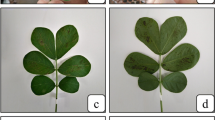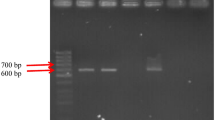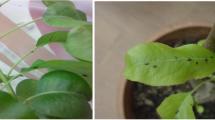Abstract
The vector-borne bacterium Xylella fastidiosa subsp. pauca is the etiological agent of important plant diseases, such as citrus variegated chlorosis (CVC). Biological studies are relatively scarce for CVC, in part because citrus is a low titer woody host, in which X. fastidiosa has a long incubation period and low transmission efficiency by vectors. To optimize transmission bioassays, this study was conducted to: i) identify herbaceous plants that allow rapid multiplication and systemic colonization of CVC strains; and ii) evaluate the herbaceous hosts for feeding and survival of the sharpshooter vector, Bucephalogonia xanthophis (Berg), and as indicators of infection after vector inoculation. Mechanical inoculations showed systemic colonization of X. fastidiosa in seven plant species, with higher rates of infection mainly in Catharanthus roseus. The lowest vector mortality was observed on C. roseus, Medicago sativa and Ocimum basilicum. The highest feeding rate was verified on O. basilicum, followed by M. sativa and C. roseus. Infections after vector inoculation were detected in C. roseus, M. sativa, O. basilicum and S. americanum. Among the plant species tested, C. roseus proved to be the most suitable experimental plant for transmission assays with CVC strains of X. fastidiosa subsp. pauca.


Similar content being viewed by others
References
Almeida, R. P. P., Pereira, E. F., Purcell, A. H., & Lopes, J. R. S. (2001). Multiplication and movement of a citrus strain of Xylella fastidiosa within sweet orange. Plant Disease, 85, 382–386.
Andersen, P. C., Brodbeck, B. V., & Mizell III, R. F. (1992). Feeding by the leafhopper, Homalodisca coagulata, in relation to xylem fluid chemistry and tension. Journal of Insect Physiology, 38, 611–622.
Brodbeck, B. V., Mizell III, R. F., & Andersen, P. C. (1993). Physiological and behavioral adaptations three species of leafhoppers in response to the dilute nutrient content of xylem fluid. Journal Insect Physiology, 39, 73–81.
Coletta-Filho, H. D., Francisco, C. F., Lopes, J. R. S., Muller, C., & Almeida, R. P. P. (2017). Homologous recombination and Xylella fastidiosa host-pathogen association in South America. Phytopathology, 107, 305–312.
Daugherty, M. P., Lopes, J. R. S., & Almeida, R. P. P. (2010). Vector within-host feeding preference mediates transmission of a heterogeneously distributed pathogen. Ecological Entomology, 35, 360–366.
EFSA 2019. Update of the Scientific Opinion on the risks to plant health posed by Xylella fastidiosa in the EU territory. EFSA Journal 17: 200 pp.
Eigenbrode, S. D., Bosque-Pérez, N. A., & Davis, T. S. (2018). Insect-borne plant pathogens and their vectors: Ecology, evolution, and complex interactions. Annual Review of Entomology, 63, 161–191.
Esteves, M. B., Kleina, H. T., Sales, T. M., Oliveira, T. P., De Lara, I. A. R., Almeida, R. P. P., Coletta-Filho, H. D., & Lopes, J. R. S. (2019). Transmission efficiency of Xylella fastidiosa subsp. pauca sequence types by sharpshooter vectors after in vitro acquisition. Phytopathology, 109, 286–293.
Fundecitrus (Fundo de Defesa da Citricultura). (2019). Levantamento da incidência das doenças dos citros, greening, CVC e cancro cítrico no cinturão citrícola de São Paulo e Triângulo/Sudoeste mineiro. Available in: https://www.fundecitrus.com.br/pdf/levantamentos/levantamento-doencas-2019.pdf. Accessed 10 Feb 2020.
Hill, B. L., & Purcell, A. H. (1995). Multiplication and movement of Xylella fastidiosa within grapevine and four other plants. Phytopatology, 85, 1368–1372.
Hill, B. L., & Purcell, A. H. (1997). Populations of Xyella fastidiosa in plants required for transmission by an efficient vector. Phytopathology, 87, 1997–1201.
Hopkins, D. L. (1985). Physiological and pathological characteristics of virulent and avirulent strains of the bacterium that causes Pierce’s disease of grapevine. The american Phytopathological society, 75, 713–717.
Hopkins, D. L. (1989). Xylella fastidiosa: Xylem-limited bacterial pathogen of plants. Annual Review of Phytopathology, 27, 271–290.
Hopkins, D. L., & Purcell, A. H. (2002). Xylella fastidiosa: Cause of Pierce’s disease of grapevine and other emergent diseases. Plant Disease, 86, 1056–1066.
Lee, R. F., Beretta, M. J. G., Hartung, J. H., Hooker, M. F., & Derrick, K. S. (1993). Citrus variegated chlorosis: Confirmation of a Xylella fastidiosa as the causal agent. Summa Phytopathologica, 19, 123–125.
Lopes, S. A., Ribeiro, D. M., Roberto, P. G., & França, S. C. (2000). Nicotiana tabacum as an experimental host for the study of plant-Xylella fastidiosa interactions. Plant Disease, 84, 827–830.
Lopes, S. A., Marcussi, S., Torres, S. C. Z., Souza, V., Fagan, C., & França, S. C. (2003). Weeds as alternative hosts of the citrus, coffee, and plum strains of Xylella fastidiosa in Brazil. Plant Disease, 87, 544–549.
Lopes, J. R. S., Daugherty, M. P., & Almeida, R. P. P. (2009). Context dependent transmission of a generalist plant pathogen: Host species and pathogen strain mediate insect vector competence. Entomologia Experimentalis et Applicata, 13, 216–224.
Lopes, J. R. S., Daugherty, M. P., & Almeida, R. P. P. (2010). Strain origin drives virulence and persistence of Xylella fastidiosa in alfalfa. Plant Pathology, 59, 963–971.
Marucci, R. C., Giustolin, T. A., Miranda, M. P., Miquelote, H., Almeida, R. P. P., & Lopes, J. R. S. (2003). Identitication of a non-host plant of Xylella fastidiosa to rear healthy sharpshooter vectors. Scientia Agricola, 60, 669–675.
Marucci, R. C., Lopes, J. R. S., Vendramim, J. D., & Corrente, J. E. (2005). Influence of Xylella fastidiosa infection of citrus on host selections by leafhopper vectors. Entomologia Experimentalis et Applicata, 113, 95–103.
Milanez, J. M., Parra, J. R. P., Custódio, I. A., Magri, D. C., Cera, C., & Lopes, J. R. S. (2003). Feeding and survival of citrus sharpshooters (Hemiptera: Cicadellidae) on host plants. Florida Entomologist, 86, 154–157.
Minsavage, G. V., Thompson, C. M., Hopkins, D. L., Leite, R. M. V. B., & Stall, R. E. (1994). Development of a polymerase chain reaction protocol for detection of Xylella fastidiosa in plant tissue. Phytopathology, 84, 456–461.
Monteiro, P. B., Renaudin, J., Jagoueix-eveillard, S., Ayres, A. J., Garnier, M., & Bové, J. M. (2001). Catharanthus roseus, an experimental host plant for the citrus strain of Xylella fastidiosa. Plant Disease, 85, 246–251.
Montesino, J. H., Coelho, J. H. C., Felippe, M. R., & Yamamoto, P. T. (2006). Ingestão de seiva do xilema de laranjeiras “Pêra” e “Valência” (Citrus sinensis (L.) Osbeck) sadias e infectadas por Xylella fastidiosa, pelas cigarrinhas vetoras Oncometopia facialis e Dilobopterus costalimai (Hemiptera: Cicadellidae). Revista Brasileira de Fruticultura, 28, 199–204.
Murray, M. G., & Thompson, W. F. (1980). Rapid isolation of high molecular weight plant DNA. Nucleic Acids Research, 8, 4321–4325.
Nielson, M. W. (1968). The leafhopper vectors of phytopathogenic viruses (Homoptera, Cicadellidae): Taxonomy, biology and virus transmission. U.S. Dept. agricultural. Technical Bulletin, 1382, 1–386.
Orlovskis, Z., Canale, M. C., Thole, V., Pecher, P., Lopes, J. R. S., & Hogenhout, S. A. (2015). Insect-borne plant pathogenic bacteria: Getting a ride goes beyond physical contact. Current Opinion In Insect Science, 9, 16–23.
Pohlert, T. (2014). The pairwise multiple comparison of mean ranks package (PMCMR). R package. https://CRAN.R-Przoject.org/package=PMCMR. Accessed 15 Sept 2020.
Purcell, A. H., & Saunders, S. R. (1999). Fate of Pierce’s disease strains of Xylella fastidiosa in common riparian plants in California. Plant Disease, 83, 825–830.
R Core Team. (2019). R: A language and environment for statistical computing. Vienna: R Foundation for Statistical Computing http://www.R-project.org. Accessed 17 Sept 2020.
Redak, R. A., Purcell, A. H., Lopes, J. R. S., Blua, M. J., Mizell III, R. F., & Andersen, P. C. (2004). The biology of xylem fluid-feeding insect vectors of Xylella fastidiosa and their relation to disease epidemiology. Annual Review of Entomology, 49, 243–270.
Saponari, M., Loconsole, G., Cornara, D., Yokomi, R. K., De Stradis, A., Boscia, D., Bosco, D., Martelli, G. P., Krugner, R., & Porcelli, F. (2014). Infectivity and transmission of Xylella fastidiosa by Phylaenus spumarius (Hemiptera: Aphrophoridae) in Apulia Italy. Journal of Economic Entomology, 107, 1316–1319.
Schaad, N. W., Postnikova, E., Lacy, G., Fatmi, M., & Chang, C. J. (2004). Xylella fastidiosa subspecies: X. fastidiosa subsp. piercei, subsp. nov., X. fastidiosa subsp. multiplex, subsp. nov., and X. fastidiosa subsp. pauca, subsp. nov. Systematic and Applied Microbiology, 27, 290–300.
Wistrom, A., & Purcell, A. H. (2005). The fate of Xylella fastidiosa in vineyard weeds and other alternate hosts in California. Plant Disease, 89, 994–999.
Zimmermam, M. H. (1983). Xylem structure and the ascent of sap. Springer-Verlag, Berlin-Heldelberg, New York, Tokyo.
Acknowledgments
This work is part of the first author’s master thesis, who received a fellowship from ‘Brazilian National Council for Scientific and Technological Development’ (CNPq Proc. No.131523/2013-9). The last author also received fellowship from CNPq (Proc. No. 310554/2016-0). The second author received a fellowship from ‘Coordenação de Aperfeiçoamento de Pessoal de Nível Superior’ - Brasil (CAPES) - Finance Code 001.
Funding
This research was funded by the Brazilian National Council for Scientific and Technological Development’ (CNPq) and by ‘Coordenação de Aperfeiçoamento de Pessoal de Nível Superior’ - Brasil (CAPES).
Author information
Authors and Affiliations
Contributions
All authors contributed to the study conception and design. The first draft of the manuscript was written by the first author and all coauthors commented on previous versions of the manuscript. All authors read and approved the final manuscript.
Corresponding author
Ethics declarations
Conflict of interest
The authors declare that they have no conflict of interest.
Ethics approval
This article does not contain any studies with participants or animals performed by any of the authors.
Electronic supplementary material
ESM 1
(DOCX 18 kb)
Rights and permissions
About this article
Cite this article
Esteves, M.B., Kleina, H.T., de M. Sales, T. et al. Selection of host plants for vector transmission assays of citrus variegated chlorosis strains of Xylella fastidiosa subsp. pauca. Eur J Plant Pathol 158, 975–985 (2020). https://doi.org/10.1007/s10658-020-02134-2
Accepted:
Published:
Issue Date:
DOI: https://doi.org/10.1007/s10658-020-02134-2




